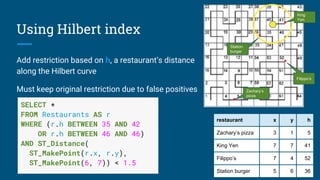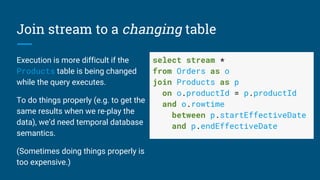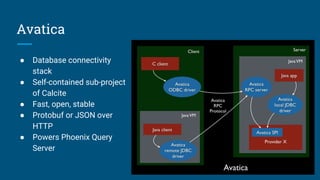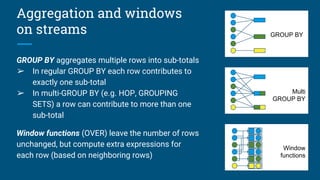Data all over the place! How SQL and Apache Calcite bring sanity to streaming and spatial data
- 1. Data all over the place! How SQL and Apache Calcite bring sanity to streaming and spatial data Julian Hyde | Lyft | 2018/06/27
- 2. @julianhyde SQL Query planning Query federation OLAP Streaming Hadoop ASF member Original author of Apache Calcite PMC Apache Arrow, Calcite, Drill, Eagle, Kylin Architect at Looker
- 3. Overview Apache Calcite - What is it, exactly? Streaming SQL / standardizing / how Calcite helps Spatial / accelerated by materialized views / spatial + streaming
- 4. 1. Calcite
- 5. Apache Calcite Apache top-level project Query planning framework used in many projects and products Also works standalone: embedded federated query engine with SQL / JDBC front end Apache community development model http://calcite.apache.org http://github.com/apache/calcite
- 6. Apache Calcite - Project goals Make it easier to write a simple DBMS Advance the state of the art for complex DBMS by pooling resources Bring database approaches to new areas (e.g. streaming) Allow create a DBMS by composing pieces (federation, etc.) Customize by plugging into framework, evolving framework when necessary Apache license & governance
- 7. Architecture Core – Operator expressions (relational algebra) and planner (based on Volcano/Cascades[2]) External – Data storage, algorithms and catalog Optional – SQL parser, JDBC & ODBC drivers Extensible – Planner rewrite rules, statistics, cost model, algebra, UDFs
- 8. Planning queries MySQL Splunk join Key: productId group Key: productName Agg: count filter Condition: action = 'purchase' sort Key: c desc scan scan Table: products select p.productName, count(*) as c from splunk.splunk as s join mysql.products as p on s.productId = p.productId where s.action = 'purchase' group by p.productName order by c desc Table: splunk
- 9. Optimized query MySQL Splunk join Key: productId group Key: productName Agg: count filter Condition: action = 'purchase' sort Key: c desc scan scan Table: splunk Table: products select p.productName, count(*) as c from splunk.splunk as s join mysql.products as p on s.productId = p.productId where s.action = 'purchase' group by p.productName order by c desc
- 10. Calcite framework Cost, statistics RelOptCost RelOptCostFactory RelMetadataProvider • RelMdColumnUniquensss • RelMdDistinctRowCount • RelMdSelectivity SQL parser SqlNode SqlParser SqlValidator Transformation rules RelOptRule • FilterMergeRule • AggregateUnionTransposeRule • 100+ more Global transformations • Unification (materialized view) • Column trimming • De-correlation Relational algebra RelNode (operator) • TableScan • Filter • Project • Union • Aggregate • … RelDataType (type) RexNode (expression) RelTrait (physical property) • RelConvention (calling-convention) • RelCollation (sortedness) • RelDistribution (partitioning) RelBuilder JDBC driver Metadata Schema Table Function • TableFunction • TableMacro Lattice
- 11. 1. Plans start as logical nodes. 3. Fire rules to propagate conventions to other nodes. 2. Assign each Scan its table’s native convention. 4. The best plan may use an engine not tied to any native format. To implement, generate a program that calls out to query1 and query2. Join Filter Scan ScanScan Join Conventions Join Filter Scan ScanScan Join Scan ScanScan Join Filter Join Join Filter Scan ScanScan Join
- 12. Adapters Scan Scan Join Filter Join Scan Conventions provide a uniform representation for hybrid queries Like ordering and distribution, conventions are a physical property of nodes Adapter = schema factory (lists tables) + convention + rules to convert nodes to a convention Example adapters: file, web, MongoDB, Druid, Drill, Spark, Flink
- 13. 2. Streaming
- 14. Data center Why SQL? Data in motion, data at rest - it’s all just data Stream / database duality SQL is the best language ever created for data (because it’s declarative)
- 15. Calcite and streaming SQL Building a streaming SQL standard via consensus ● Please! No more “SQL-like” languages! Toolkit for building a streaming SQL engine ● Key technologies are open source (many are Apache projects) ● Use Calcite’s framework to build a streaming SQL parser/planner for your engine Developing example queries, data sets, TCK
- 16. Simple queries select * from Products where unitPrice < 20 select stream * from Orders where units > 1000 ➢ Traditional (non-streaming) ➢ Products is a table ➢ Retrieves records from -∞ to now ➢ Streaming ➢ Orders is a stream ➢ Retrieves records from now to +∞ ➢ Query never terminates
- 17. Stream-table duality select * from Orders where units > 1000 ➢ Yes, you can use a stream as a table ➢ And you can use a table as a stream ➢ Actually, Orders is both ➢ Use the stream keyword ➢ Where to actually find the data? That’s up to the system select stream * from Orders where units > 1000
- 18. Hybrid query combines a stream with its own history ● Orders is used as both as stream and as “stream history” virtual table ● “Average order size over last year” should be maintained by the system, i.e. a materialized view select stream * from Orders as o where units > ( select avg(units) from Orders as h where h.productId = o.productId and h.rowtime > o.rowtime - interval ‘1’ year) “Orders” used as a stream “Orders” used as a “stream history” virtual table
- 19. Other operations Other relational operations make sense on streams (usually only if there is an implicit time bound). Examples: ● order by – E.g. Each hour emit the top 10 selling products ● union – E.g. Merge streams of orders and shipments ● insert, update, delete – E.g. Continuously insert into an external table ● exists, in sub-queries – E.g. Show me shipments of products for which there has been no order in the last hour ● view – Expanded when query is parsed; zero runtime cost ● match_recognize – Complex event processing (CEP)
- 20. “Standard streaming SQL” Consistent semantics over tables (if database contains both streams and tables) Consistent semantics over streams. The replay principle: A streaming query produces the same result as the corresponding non-streaming query would if given the same data in a table. Consistent look and feel (e.g. same data types, keywords) Some hard problems remain... mainly concerning time…
- 21. Controlling when data is emitted Early emission is the defining characteristic of a streaming query. The emit clause is a SQL extension inspired by Apache Beam’s “trigger” notion. (Still experimental… and evolving.) A relational (non-streaming) query is just a query with the most conservative possible emission strategy. select stream productId, count(*) as c from Orders group by productId, floor(rowtime to hour) emit at watermark, early interval ‘2’ minute, late limit 1 select * from Orders emit when complete
- 22. Event time Example streams and query so far have used a rowtime column ● Is rowtime a system column, or can streams choose their own sort key? ● Can a stream have more than one sort key? ● Is rowtime’s type always TIMESTAMP? ● Is a stream totally sorted on rowtime? Alternatives: ○ K-sorted: Every row is within 100 rows of sorted ○ T-sorted: Every row is within 5 minutes of sorted ○ Bounded latency: Every row is within 10 minutes of wallclock time ○ Watermark: An upper-bound on rows’ delay, allows early emit
- 23. Event time in queries We’ve sorted out event time in streams… what about derived streams (queries / views)? Given a streaming query: ● What are its sort keys? ● What is the maximum delay of rows? ● Does the system refuse to run queries with unbounded delay? SQL syntax to promote a query column to a sort key select count(*) from Orders group by floor( rowtime to hour) select count(*) from Orders select shipTime as rowtime from Orders order by shipTime ?
- 24. Models of relations A table is a multi-set of records; contents vary over time, with some kind transactional consistency A temporal table is like a table, but you can also query its contents at previous times; usually mapped to a base table with (start, end) columns So, what is a stream? 1. A stream is an append-only table with an event-time column 2. Or, if you speak monads[3], a stream is a function: Stream x → Time → Bag x 3. Or, a stream is the time-derivative of a table Are a table, its temporal table, and its stream one catalog object or three?
- 25. The “pie chart” problem ● Task – Write dashboard of orders over last hour ● Problem – The Orders stream only contains the current few records ● Solution – Materialize short-term history ● Question – Does the developer maintain that mapping, or does the DBMS do it automatically? Orders over the last hour Beer 48% Cheese 30% Wine 22% select productId, count(*) from Orders where rowtime > current_timestamp - interval ‘1’ hour group by productId
- 26. Transactions & isolation In a regular database, INSERT, UPDATE and DELETE are transactional operations; SELECT is not In a streaming database, SELECT might be transactional too ● Consider a pub-sub system: the system acknowledges when you send a message, you must acknowledge when you receive a message In a regular database query, snapshot isolation freezes the database in time; in a streaming query, we don’t want that
- 27. Stream to stream join Stream to table join Stream to temporal table join “as of” is based on SQL:2011 temporal syntax Joins select stream * from Orders as o join Shipments as s on s.orderId = o.orderId and s.rowtime between o.rowtime and o.rowtime + interval ‘1’ hour select stream * from Orders as o join Products as p on p.productId = o.productId select stream * from Orders as o join TemporalProducts as of o.rowtime as p on p.productId = o.productId
- 28. 3. Spatial
- 29. Spatial query Find all restaurants within 1.5 distance units of my location (6, 7) restaurant x y Zachary’s pizza 3 1 King Yen 7 7 Filippo’s 7 4 Station burger 5 6 • • • • Zachary’s pizza Filippo’s King Yen Station burger
- 30. Spatial query Find all restaurants within 1.5 distance units of my location (6, 7) Using OpenGIS SQL extensions: restaurant x y Zachary’s pizza 3 1 King Yen 7 7 Filippo’s 7 4 Station burger 5 6 SELECT * FROM Restaurants AS r WHERE ST_Distance( ST_MakePoint(r.x, r.y), ST_MakePoint(6, 7)) < 1.5 • • • • Zachary’s pizza Filippo’s King Yen Station burger
- 31. Efficient spatial query? Spatial queries are hard to execute efficiently. Conventional DBs use two tricks that don’t work: ● Hash (no ranges / no locality) ● Sort (only one-dimensional ranges) Two techniques that do work[4]: ● Data-organized structures (e.g. r-tree) – self-balancing ● Space-organized structures (e.g. tiles) – allow algebraic rewrite Algebraic rewrites work on general-purpose data structures, and they compose. • • • • A scan over a two-dimensional index only has locality in one dimension
- 32. Hilbert space-filling curve ● A space-filling curve invented by mathematician David Hilbert ● Every (x, y) point has a unique position on the curve ● Points near to each other typically have Hilbert indexes close together
- 33. • • • • Add restriction based on h, a restaurant’s distance along the Hilbert curve Must keep original restriction due to false positives Using Hilbert index restaurant x y h Zachary’s pizza 3 1 5 King Yen 7 7 41 Filippo’s 7 4 52 Station burger 5 6 36 Zachary’s pizza Filippo’s SELECT * FROM Restaurants AS r WHERE (r.h BETWEEN 35 AND 42 OR r.h BETWEEN 46 AND 46) AND ST_Distance( ST_MakePoint(r.x, r.y), ST_MakePoint(6, 7)) < 1.5 King Yen Station burger
- 34. Telling the optimizer 1. Declare h as a generated column 2. Sort table by h Planner can now convert spatial range queries into a range scan Does not require specialized spatial index such as r-tree Very efficient on a sorted table such as HBase CREATE TABLE Restaurants ( restaurant VARCHAR(20), x DOUBLE, y DOUBLE, h DOUBLE GENERATED ALWAYS AS ST_Hilbert(x, y) STORED) SORT KEY (h); restaurant x y h Zachary’s pizza 3 1 5 Station burger 5 6 36 King Yen 7 7 41 Filippo’s 7 4 52
- 35. More spatial queries What state am I in? (point-to-polygon) Which states does Yellowstone NP intersect? (polygon-to-polygon)
- 36. More spatial queries What state am I in? (point-to-polygon) Which states does Yellowstone NP intersect? (polygon-to-polygon) SELECT * FROM States AS s WHERE ST_Intersects(s.geometry, ST_MakePoint(6, 7)) SELECT * FROM States AS s WHERE ST_Intersects(s.geometry, ST_GeomFromText('LINESTRING(...)'))
- 37. Point-to-polygon query What state am I in? (point-to-polygon) 1. Divide the plane into tiles, and pre-compute the state-tile intersections 2. Use this ‘tile index’ to narrow list of states SELECT s.* FROM States AS s WHERE s.stateId IN (SELECT stateId FROM StateTiles AS t WHERE t.tileId = 8) AND ST_Intersects(s.geometry, ST_MakePoint(6, 7))
- 38. Building the tile index Use the ST_MakeGrid function to decompose each state into a series of tiles Store the results in a table, sorted by tile id A materialized view is a table that remembers how it was computed, so the planner can rewrite queries to use it CREATE MATERIALIZED VIEW StateTiles AS SELECT s.stateId, t.geometry, t.tileId, t.id_col, t.id_row FROM States AS s, LATERAL TABLE(ST_MakeGrid(s.stateId, 4, 4)) AS t
- 39. Streaming + spatial Every minute, emit the number of journeys that have intersected each city. (Some journeys intersect multiple cities.) (Efficient implementation is left as an exercise to the reader. Probably involves splitting journeys into tiles, partitioning by tile hash-code, intersecting with cities in those tiles, then rolling up cities.) SELECT STREAM c.name, COUNT(*) FROM Journeys AS j CROSS JOIN Cities AS c ON ST_Intersects(c.geometry, j.geometry) GROUP BY c.name, FLOOR(j.rowtime TO HOUR)
- 40. 4. Conclusion
- 41. Why SQL? Common language across paradigms (OLTP, analytics, streaming, spatial, graph, search…) and workloads (batch, transactional, continuous) SQL is standard (and growing) Relational algebra allows a planner to transform queries Materialized views (indexes, caches) allow you to optimize your data SQL Algebra Applications with various workloads Data stores
- 42. Thank you! Questions? References 1. Edmon Begoli, Jesús Camacho Rodríguez, Julian Hyde, Michael Mior, Daniel Lemire. 2018. Apache Calcite: A Foundational Framework for Optimized Query Processing Over Heterogeneous Data Sources. SIGMOD 2018. 2. Goetz Graefe and William J. McKenna. 1993. The Volcano Optimizer Generator: Extensibility and Efficient Search. ICDE. 3. Sebastian Herbst , Andreas M. Wahl, Johannes Tenschert, Klaus Meyer-Wegener. 2018. Sequences, yet Functions: The Dual Nature of Data-Stream Processing. arXiv preprint. 4. Edwin H. Jacox, Hanan Samet. 2007. Spatial join techniques. TODS. https://calcite.apache.org @ApacheCalcite @julianhyde
- 44. Extra slides
- 45. Talk proposal Bio Julian Hyde is an expert in query optimization and in-memory analytics. He founded Apache Calcite, a framework for query optimization and data virtualization. He also founded Mondrian, the popular open source OLAP engine, and co-founded SQLstream, an early streaming SQL platform. He is an architect at Looker. Title Data all over the place! How Apache Calcite brings SQL and sanity to streaming and spatial data Abstract The revolution has happened. We are living the age of the deconstructed database. The modern enterprises are powered by data, and that data lives in many formats and locations, in-flight and at rest, but somewhat surprisingly, the lingua franca for remains SQL. In this talk, Julian describes Apache Calcite, a toolkit for relational algebra that powers many systems including Apache Beam, Flink and Hive. He discusses some areas of development in Calcite: streaming SQL, materialized views, enabling spatial query on vanilla databases, and what a mash-up of all three might look like.
- 46. Other applications of data profiling Query optimization: ● Planners are poor at estimating selectivity of conditions after N-way join (especially on real data) ● New join-order benchmark: “Movies made by French directors tend to have French actors” ● Predict number of reducers in MapReduce & Spark “Grokking” a data set Identifying problems in normalization, partitioning, quality Applications in machine learning?
- 47. Further improvements ● Build sketches in parallel ● Run algorithm in a distributed framework (Spark or MapReduce) ● Compute histograms ○ For example, Median age for male/female customers ● Seek out functional dependencies ○ Once you know FDs, a lot of cardinalities are no longer “surprising” ○ FDs occur in denormalized tables, e.g. star schemas ● Smarter criteria for stopping algorithm ● Skew/heavy hitters. Are some values much more frequent than others? ● Conditional cardinalities and functional dependencies ○ Does one partition of the data behave differently from others? (e.g. year=2005, state=LA)
- 48. Relational algebra (plus streaming) Core operators: ➢ Scan ➢ Filter ➢ Project ➢ Join ➢ Sort ➢ Aggregate ➢ Union ➢ Values Streaming operators: ➢ Delta (converts relation to stream) ➢ Chi (converts stream to relation) In SQL, the STREAM keyword signifies Delta
- 49. Streaming algebra ➢ Filter ➢ Route ➢ Partition ➢ Round-robin ➢ Queue ➢ Aggregate ➢ Merge ➢ Store ➢ Replay ➢ Sort ➢ Lookup
- 50. Optimizing streaming queries The usual relational transformations still apply: push filters and projects towards sources, eliminate empty inputs, etc. The transformations for delta are mostly simple: ➢ Delta(Filter(r, predicate)) → Filter(Delta(r), predicate) ➢ Delta(Project(r, e0, ...)) → Project(Delta(r), e0, …) ➢ Delta(Union(r0, r1), ALL) → Union(Delta(r0), Delta(r1)) But not always: ➢ Delta(Join(r0, r1, predicate)) → Union(Join(r0, Delta(r1)), Join(Delta(r0), r1) ➢ Delta(Scan(aTable)) → Empty
- 51. Sliding windows in SQL select stream sum(units) over w (partition by productId) as units1hp, sum(units) over w as units1h, rowtime, productId, units from Orders window w as (order by rowtime range interval ‘1’ hour preceding) rowtime productId units 09:12 100 5 09:25 130 10 09:59 100 3 10:17 100 10 units1hp units1h rowtime productId units 5 5 09:12 100 5 10 15 09:25 130 10 8 18 09:59 100 3 23 13 10:17 100 10
- 52. Join stream to a changing table Execution is more difficult if the Products table is being changed while the query executes. To do things properly (e.g. to get the same results when we re-play the data), we’d need temporal database semantics. (Sometimes doing things properly is too expensive.) select stream * from Orders as o join Products as p on o.productId = p.productId and o.rowtime between p.startEffectiveDate and p.endEffectiveDate
- 53. Calcite design Design goals: ● Not-just-SQL front end ● Federation ● Extensibility ● Caching / hybrid storage ● Materialized views Design points: ● Relational algebra foundation ● Composable transformation rules ● Support different physical engines ● Pluggable cost model, statistics, planning life-cycle tables on disk in-memory materializationsselect x, sum(y) from t group by x
- 54. Avatica ● Database connectivity stack ● Self-contained sub-project of Calcite ● Fast, open, stable ● Protobuf or JSON over HTTP ● Powers Phoenix Query Server
- 55. Aggregation and windows on streams GROUP BY aggregates multiple rows into sub-totals ➢ In regular GROUP BY each row contributes to exactly one sub-total ➢ In multi-GROUP BY (e.g. HOP, GROUPING SETS) a row can contribute to more than one sub-total Window functions (OVER) leave the number of rows unchanged, but compute extra expressions for each row (based on neighboring rows) Multi GROUP BY Window functions GROUP BY
- 56. Tumbling, hopping & session windows in SQL Tumbling window Hopping window Session window select stream … from Orders group by floor(rowtime to hour) select stream … from Orders group by tumble(rowtime, interval ‘1’ hour) select stream … from Orders group by hop(rowtime, interval ‘1’ hour, interval ‘2’ hour) select stream … from Orders group by session(rowtime, interval ‘1’ hour)





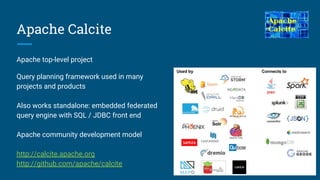

![Architecture
Core – Operator expressions
(relational algebra) and planner
(based on Volcano/Cascades[2])
External – Data storage, algorithms
and catalog
Optional – SQL parser, JDBC &
ODBC drivers
Extensible – Planner rewrite rules,
statistics, cost model, algebra, UDFs](https://image.slidesharecdn.com/calcite-lyft-2018-180628001402/85/Data-all-over-the-place-How-SQL-and-Apache-Calcite-bring-sanity-to-streaming-and-spatial-data-7-320.jpg)















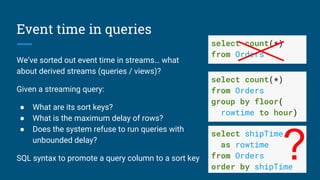
![Models of relations
A table is a multi-set of records; contents vary over time, with some kind
transactional consistency
A temporal table is like a table, but you can also query its contents at previous
times; usually mapped to a base table with (start, end) columns
So, what is a stream?
1. A stream is an append-only table with an event-time column
2. Or, if you speak monads[3], a stream is a function: Stream x → Time → Bag x
3. Or, a stream is the time-derivative of a table
Are a table, its temporal table, and its stream one catalog object or three?](https://image.slidesharecdn.com/calcite-lyft-2018-180628001402/85/Data-all-over-the-place-How-SQL-and-Apache-Calcite-bring-sanity-to-streaming-and-spatial-data-24-320.jpg)



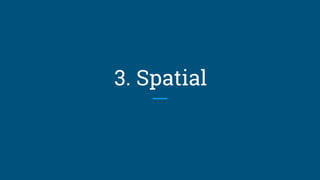


![Efficient spatial query?
Spatial queries are hard to execute efficiently.
Conventional DBs use two tricks that don’t work:
● Hash (no ranges / no locality)
● Sort (only one-dimensional ranges)
Two techniques that do work[4]:
● Data-organized structures (e.g. r-tree) – self-balancing
● Space-organized structures (e.g. tiles) – allow algebraic rewrite
Algebraic rewrites work on general-purpose data structures, and they compose.
•
•
•
•
A scan over a two-dimensional index only
has locality in one dimension](https://image.slidesharecdn.com/calcite-lyft-2018-180628001402/85/Data-all-over-the-place-How-SQL-and-Apache-Calcite-bring-sanity-to-streaming-and-spatial-data-31-320.jpg)

